Click on the map below to learn more

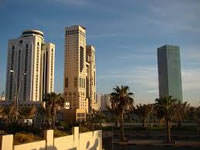 |
Tripoli, LibyaTripoli is the capital and largest city in Libya. Located on the edge of the Libyan Desert, Tripoli is the nation's commercial center with a population of about 1.1 million people. Tripoli was the primary base of the famed Barbary Pirates, the naval branch of the Ottoman Empire that once ruled the Mediterranean Sea and which once kidnapped and enslaved sailors from nation's that had not paid their yearly tributes for free navigation of the sea. The Barbary Pirates were finally dispatched in the early 1800's by the new United States navy, which fought its first foreign war along "the shores of Tripoli." |
| Back to Map | |
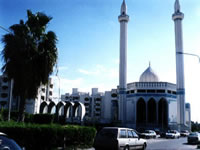 |
Misrata, LibyaWith a population of about 281,000, Misrata is Libya's third largest city and one of its principal commerce hubs, though many of the business once located downtown were destroyed in the 2011 Siege of Misrata during the Libyan Civil War. Nevertheless, Misrata remains an important production center for steel production. In the 1800s, Misrata was an important center on the Trans-Sahara Trade Route, where caravans carrying gold, leather, and slaves could stop and get supplies. |
| Back to Map | |
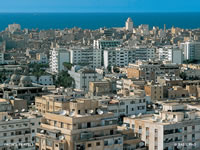 |
Benghazi, LibyaBenghazi, a port city on the Mediterranean Sea in eastern Libya, is the nation's second largest city with a population of over 630,000. Benghazi is home to the headquarters of many of Libya's largest corporations, and is also home to Libya's Parliament, which is unusual because Parliaments usually reside in a nation's capital city. Recently, Benghazi has been the site of numerous uprisings, revolts, riots, battles, and violent episodes during the Libyan Civil War. |
| Back to Map | |
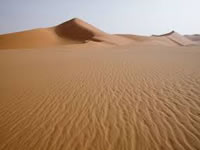 |
Libyan DesertThe Libyan Desert forms the northern and western parts of the Sahara Desert in eastern Libya, western Egypt, and northern Sudan. Like most of the Sahara, the Libyan Desert is characterized by vast areas of sand and stony plains. The Libyan Desert features three famous sand seas: The Great Sand Sea, the Calanshio Sand Sea and the Rebiana Sand Sea. In the Libyan Desert a substance called Libyan Glass is common. This desert glass is a naturally formed glass most likely formed from lightning or meteor strikes that may have occurred millions of years ago. |
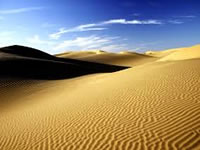 |
Sahara DesertCovering 3.6 million square miles, the Sahara Desert is the world's largest non-polar desert. It is also the world's hottest and sunniest desert. Covering most of north Africa, the Sahara Desert is roughly the size of the entire United States. Windswept sand dunes in the desert can reach heights of nearly 600 feet. Parts of the Sahara Desert can go decades without receiving any rainfall. With some rare rainfall in the Sahara, the raindrops can evaporate before hitting the sandy surface.
|
| Back to Map | |
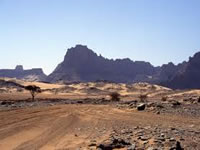 |
Bikku BittiBikku Bitti is the highest peak in Libya, rising to an altitude of 7,434 feet. Located on the Libya-Chad border in the Tibetsi Range, Bikku Bitti is located in one of the most inaccessible parts of the Sahara Desert.
|
| Back to Map | |
| Population: | 6,244,174(2014) |
| Area: | 679,359 sq. miles |
| Capital City: | Tripoli |
| Largest City: | Tripoli |
| Currency: | Libyan dinar |
| Official Language: | Libyan Arabic |
| GDP (Gross Domestic Product) | $70.37 Billion |
- Libya is 4th largest country in Africa
- Libya is the 17th largest country in the world and is a little bit larger than Alaska.
- Libya has the world's tenth largest oil reserves.
- Libya was the center of fighting during the Barbary Wars between the United States and the Ottoman Navy in the early 1800s.
- Libya was part of Italy's kingdom from 1912-1943 and was called Italian North Africa from 1912-1927
- Libya recently experienced a massive Civil War as part of what came to be known as the Arab Spring, a wave of protests, riots, and civil wars that engulfed many Arab nations in 2011.
- Libya has the longest coastline of any Mediterranean nation in Africa.
- Parts of the Libyan desert may not experience rain for decades.
- The desert town of Aziziya recorded a temperature of 136 degrees Fahrenheit in 1922, one of the hottest figures ever recorded.
- Oil accounts for up to 97% of Libya's exports.
|
|
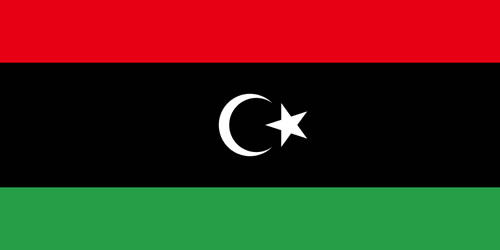 |
|
| In the Libya flag, the red represents the blood of the Libyan people who died during Italian rule, the green represents the age of independence and freedom, and the crescent and star represent Islam. | |